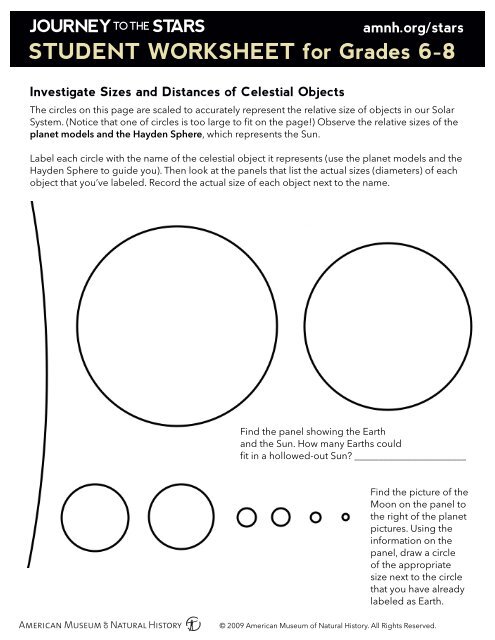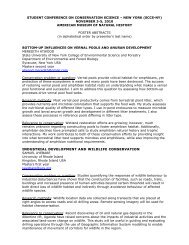STUDENT WORKSHEET for Grades 6-8 - American Museum of ...
STUDENT WORKSHEET for Grades 6-8 - American Museum of ...
STUDENT WORKSHEET for Grades 6-8 - American Museum of ...
Create successful ePaper yourself
Turn your PDF publications into a flip-book with our unique Google optimized e-Paper software.
Investigate Sizes and Distances <strong>of</strong> Celestial Objects<br />
amnh.org/stars<br />
<strong>STUDENT</strong> <strong>WORKSHEET</strong> <strong>for</strong> <strong>Grades</strong> 6-8<br />
The circles on this page are scaled to accurately represent the relative size <strong>of</strong> objects in our Solar<br />
System. (Notice that one <strong>of</strong> circles is too large to fit on the page!) Observe the relative sizes <strong>of</strong> the<br />
planet models and the Hayden Sphere, which represents the Sun.<br />
Label each circle with the name <strong>of</strong> the celestial object it represents (use the planet models and the<br />
Hayden Sphere to guide you). Then look at the panels that list the actual sizes (diameters) <strong>of</strong> each<br />
object that you’ve labeled. Record the actual size <strong>of</strong> each object next to the name.<br />
Find the panel showing the Earth<br />
and the Sun. How many Earths could<br />
fit in a hollowed-out Sun _______________________<br />
Find the picture <strong>of</strong> the<br />
Moon on the panel to<br />
the right <strong>of</strong> the planet<br />
pictures. Using the<br />
in<strong>for</strong>mation on the<br />
panel, draw a circle<br />
<strong>of</strong> the appropriate<br />
size next to the circle<br />
that you have already<br />
labeled as Earth.<br />
© 2009 <strong>American</strong> <strong>Museum</strong> <strong>of</strong> Natural History. All Rights Reserved.
<strong>STUDENT</strong> <strong>WORKSHEET</strong> <strong>for</strong> <strong>Grades</strong> 6-8<br />
Investigate Sizes and Distances <strong>of</strong> Celestial Objects<br />
amnh.org/stars<br />
The circles on this page are scaled to accurately represent the relative size <strong>of</strong> objects in our Solar<br />
System. (Notice that one <strong>of</strong> circles is too large to fit on the page!) Observe the relative sizes <strong>of</strong> the<br />
planet models and the Hayden Sphere, which represents the Sun.<br />
Label each circle with the name <strong>of</strong> the celestial object it represents (use the planet models and the<br />
Hayden Sphere to guide you). Then look at the panels that list the actual sizes (diameters) <strong>of</strong> each<br />
object that you’ve labeled. Record the actual size <strong>of</strong> each object next to the name.<br />
ANSWER KEY<br />
JUPITER<br />
140,000 kilometers<br />
SATURN<br />
120,000 kilometers<br />
SUN<br />
(Hayden<br />
Sphere)<br />
Find the panel showing the Earth<br />
and the Sun. How many Earths could<br />
fit in a hollowed-out Sun ___________________________<br />
Answer: More than a million Earths<br />
URANUS<br />
51,000<br />
kilometers<br />
NEPTUNE<br />
50,000<br />
kilometers<br />
EARTH<br />
13,000 km<br />
VENUS<br />
12,000 km<br />
MOON<br />
3,500 km<br />
MARS<br />
6,800 km<br />
MERCURY<br />
4,900 km<br />
Find the picture <strong>of</strong><br />
the Moon on the<br />
panel to the right <strong>of</strong><br />
the planet pictures.<br />
Using the in<strong>for</strong>mation<br />
on the panel, draw<br />
a circle <strong>of</strong> the<br />
appropriate size next<br />
to the circle that you<br />
have already labeled<br />
as Earth.<br />
© 2009 <strong>American</strong> <strong>Museum</strong> <strong>of</strong> Natural History. All Rights Reserved.

















